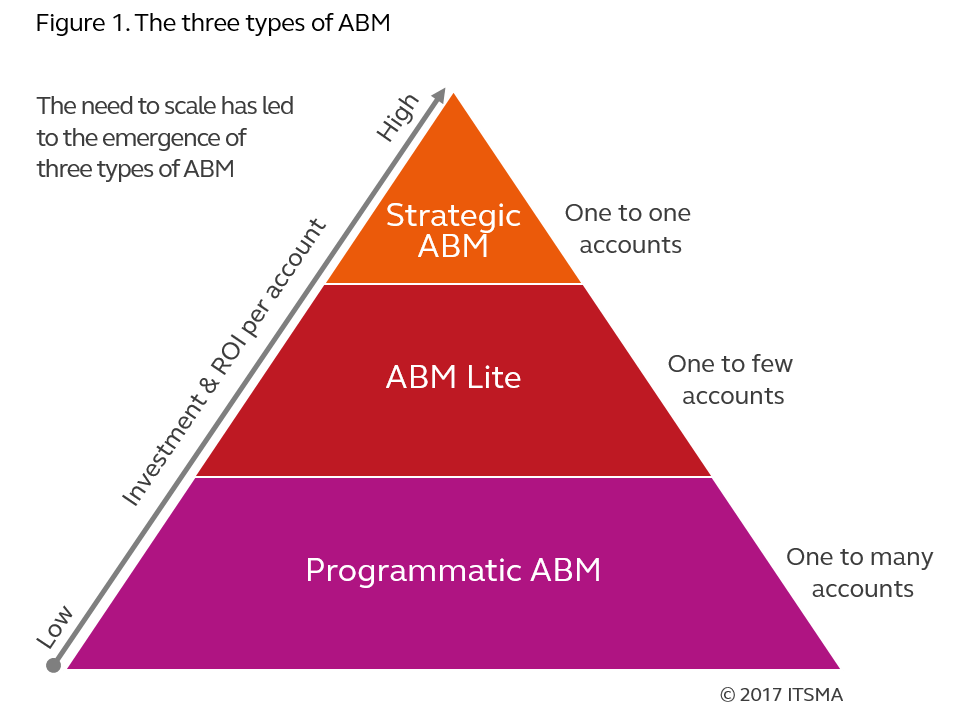It’s no secret that rapidly changing customer attitudes and behaviors are a source of stress for marketing teams as they scramble to adapt to the era of CX. This is particularly true for B2B marketing.
B2B buyers have changed—long gone are the days of waiting for someone in sales to setup calls and meetings in order to glean information. Digitization and access to information has empowered B2B buyers to be in control of the purchase relationship, and it’s up to B2B marketers to orchestrate in-the-moment customer engagements with relevant messages.
Easier said than done! But executing a successful ABM strategy is helping marketers find success.
What is account based marketing?
The account based marketing (ABM) approach involves designing and executing highly targeted, personalized marketing initiatives to drive business growth and impact with specific accounts. Of course, none of this is possible without coordination of efforts across departments.
To guide buyers on their journeys, sales and marketing must commit to working in concert to build out the ABM plan and understand each other’s roles in the process. It’s important that there’s a deep organizational commitment to obtaining and evaluating account level insights.
In order to run successful ABM, dedicated marketers must be assigned to this particular task, instead of being it a part-time job of a few marketers. Lastly, it’s imperative that a closed loop measurement structure is in place with key ABM performance indicators so that all activities can be measured and optimized.
The three tiers of ABM strategy
Let’s discuss the three primary ABM strategies-based account tiers.

1:1 ABM strategy
You’ll want to implement a 1:1 ABM strategy for the most important accounts. This typically requires creation and execution of highly customized programs for individual accounts. Here are just a few examples of positive, high-touch experiences that are deeply personalized:
- Dedicated account websites
- Executive briefing meetings
- Invitations to special events, etc…
There are several critical factors which contribute to the success of a program like this:
- Joint sales/marketing commitment
- Commitment to consolidate or obtain account level insights
- Dedicated marketers to run ABM
- Create ABM measurement structure
One-to-few ABM strategy
The second ABM tier strategy is best described as one-to-few. These named accounts typically share a common business issue or are in the same industry. This ABM strategy requires creating and executing highly customized programs for a cluster of accounts that address a common business issue.
There are key success markers for this strategy:
- Joint sales/marketing commitment
- Analytics into aggregated account insights to identify account clusters
- Trigger-based programs
One-to-many ABM strategy
The third ABM tier strategy is one-to-many, where marketers are primarily leveraging technology to tailor ABM campaigns and engagements for specific named accounts at scale. In a way, this may seem like zooming out, but the precision of ABM still holds true with success factors including the following:
- Account level insights at scale
- Segmentation and targeting
- Audience-based programs
- Demand management process
As you execute, ensure that you are in lock-step with the sales team. You’ve got to provide transparency of the plan and activities so that sales can prepare for and execute their part. You need the ability to see what’s working and what’s not so you can dynamically fine-tune your ABM strategy and tactics.
Developing the right ABM performance indicators to measure account engagements, penetration, and demand generation by accounts is crucial – it allows you to clearly see what activities are having an impact on each specific account.
The future of marketing is intelligent engagement
Account-based marketing may feel like an unnecessary approach to organizations that haven’t harnessed the power, benefits, and insights that it delivers to successfully craft more insightful marketing efforts.
Via intelligent, collaborative engagement with sales, B2B marketers can bring highly individualized experiences to their target customers, successfully engaging them and driving revenue and growth.

